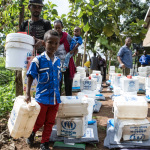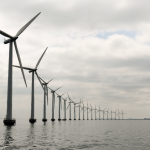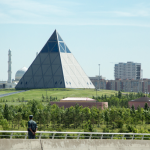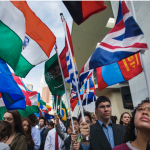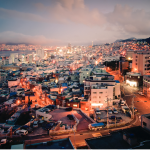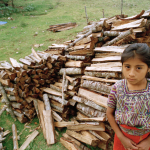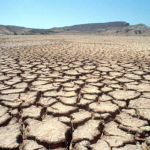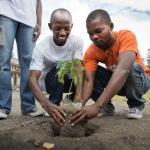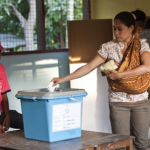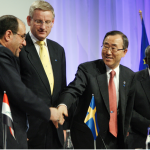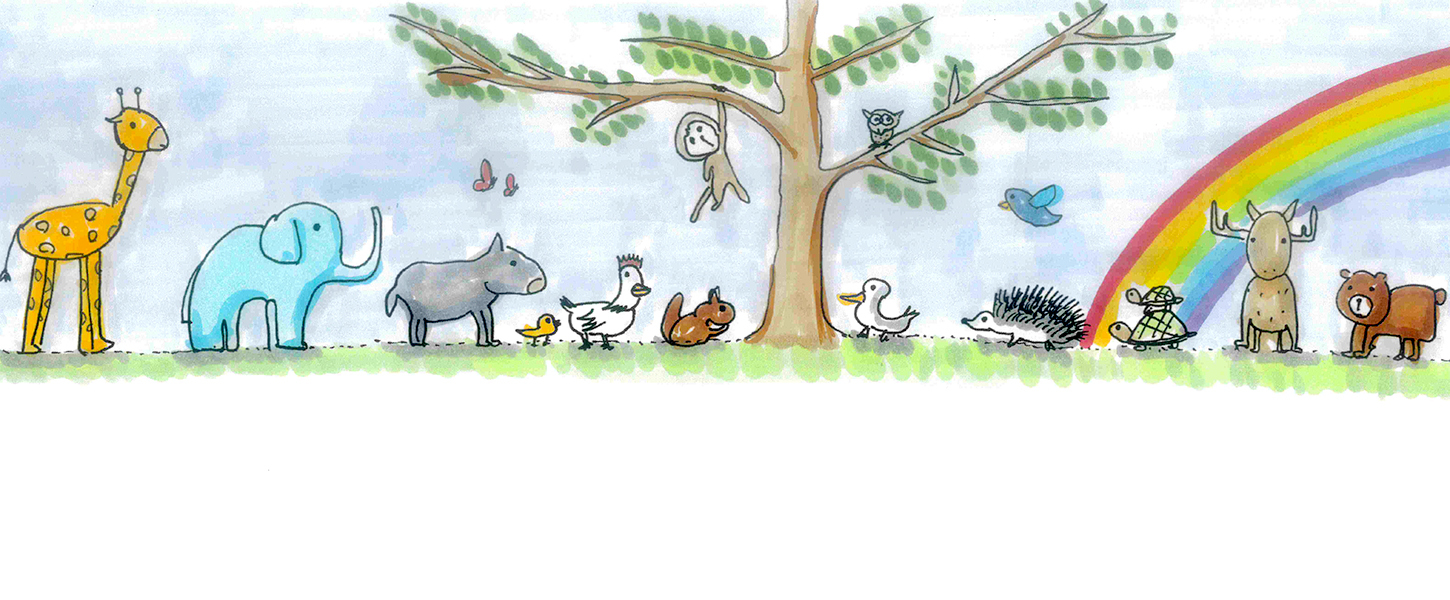
About This Website
A few years ago, I happened to see a video from National Geographic. The video was about sea turtle researchers and a sea turtle with a plastic straw stuck in his nose in the ocean. It seemed the plastic straw went into the sea turtle’s nose by accident and got stuck there for a long time. The researchers happened to find it and decided that the straw should be removed on the spot. They kept trying to remove it for good 10 minutes until they finally managed to take it out. The sea turtle started to bleed and the video was clearly shocking and painful to watch. I couldn’t help but think how our human lives and societies have been affecting other living creatures on earth like the sea turtle. The video went viral and I think some of you may have seen it too. Watching the video was a common experience from a daily life, but it triggered me to think and make an action.
Around the same time, “Sustainable Development Goals” have been decided at the United Nations. This was in the year of 2015. The member countries of the UN share those goals and try to create a better and sustainable world together in every aspect, such as humanity, poverty, and natural environment. The detailed information about SDGs is provided below.
These global movements and personal experiences finally made me make an action to do what we could do as a local design office. We, kusukusu Inc., have decided to share our ideas with public for creating a sustainable society. This website is managed by a design office kusukusu Inc., and we share ideas along with SDGs here to create sustainable societies.
On this page, you can get information about SDGs and about the goals we focus. The model town for our ideas is Kamakura city in Japan, and you can read our ideas on the VISION page.
This website can’t change the world drastically, but each of us can really think and make an action to create a better society, and work on it together.
SDGs × Kamakura
Model Town, Kamakura-city in Japan
Kamakura is a town located only 1 hour away from busy Tokyo, and it is where our office is located. Kamakura is a town that has both convenient access to larger cities and the beautiful nature. There are also problems, however, mainly due to the increasing popularity of the town. Kamakura has issues of heavy traffic jams and environmental pollution especially during holiday seasons. There are a lot of traditional wooden houses in Kamakura, but more and more of them have been demolished and replaced by new and modern concrete houses. There will be a lot of garbage on the streets in summer. It was only natural for us to feel the urge to protect the beautiful nature we have now, and build a sustainable society. This urge and a sense of emergency led us to create this website.
We have thought about how we can actually protect the nature and create a sustainable society, and come up with the idea of sharing our actions and ideas publicly. Even if it’s just a small seed of idea at the beginning, it can be one step toward creating a better world by sharing it with others. That’s what we believe.

The Goals We Focus
Among all the 17 goals, we especially focus on Goal 7: Affordable and clean energy, 11: Sustainable cities and communities, 12: Responsible consumption and production, 14: Life below water, and 15: Life on land, and think about ideas to create sustainable systems in those fields. The model town for our ideas is Kamakura, and we try to make it adaptable to other towns as well. The followings are the Goals and Targets we focus on and the articles of our ideas to improve the society in those areas.
Goal 7: Affordable and clean energy
7.1 By 2030, ensure universal access to affordable, reliable and modern energy services
7.2 By 2030, increase substantially the share of renewable energy in the global energy mix
7.3 By 2030, double the global rate of improvement in energy efficiency
7.A By 2030, enhance international cooperation to facilitate access to clean energy research and technology, including renewable energy, energy efficiency and advanced and cleaner fossil-fuel technology, and promote investment in energy infrastructure and clean energy technology
7.B By 2030, expand infrastructure and upgrade technology for supplying modern and sustainable energy services for all in developing countries, in particular least developed countries, small island developing States, and land-locked developing countries, in accordance with their respective programmes of support
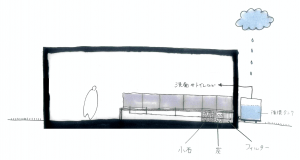
We, kusukusu Inc., think about sustainable systems in a community and at restaurants/cafes, and put them into practice.
The following article is an example of sustainable system at a cafe: The circulation of water.
Goal 11: Sustainable cities and communities
11.1 By 2030, ensure access for all to adequate, safe and affordable housing and basic services and upgrade slums
11.2 By 2030, provide access to safe, affordable, accessible and sustainable transport systems for all, improving road safety, notably by expanding public transport, with special attention to the needs of those in vulnerable situations, women, children, persons with disabilities and older persons
11.3 By 2030, enhance inclusive and sustainable urbanization and capacity for participatory, integrated and sustainable human settlement planning and management in all countries
11.4 Strengthen efforts to protect and safeguard the world’s cultural and natural heritage
11.5 By 2030, significantly reduce the number of deaths and the number of people affected and substantially decrease the direct economic losses relative to global gross domestic product caused by disasters, including water-related disasters, with a focus on protecting the poor and people in vulnerable situations
11.6 By 2030, reduce the adverse per capita environmental impact of cities, including by paying special attention to air quality and municipal and other waste management
11.7 By 2030, provide universal access to safe, inclusive and accessible, green and public spaces, in particular for women and children, older persons and persons with disabilities
11.A Support positive economic, social and environmental links between urban, peri-urban and rural areas by strengthening national and regional development planning
11.B By 2020, substantially increase the number of cities and human settlements adopting and implementing integrated policies and plans towards inclusion, resource efficiency, mitigation and adaptation to climate change, resilience to disasters, and develop and implement, in line with the Sendai Framework for Disaster Risk Reduction 2015-2030, holistic disaster risk management at all levels
11.C Support least developed countries, including through financial and technical assistance, in building sustainable and resilient buildings utilizing local materials


We put the priority on the sustainability and circulation of a system in a community and in an individual life.
For example, we have thought about creating a sustainable system in an abandoned building and adopting electronic vehicle as a community bus.
Goal 12: Responsible consumption and production
12.1 Implement the 10-year framework of programmes on sustainable consumption and production, all countries taking action, with developed countries taking the lead, taking into account the development and capabilities of developing countries
12.2 By 2030, achieve the sustainable management and efficient use of natural resources
12.3 By 2030, halve per capita global food waste at the retail and consumer levels and reduce food losses along production and supply chains, including post-harvest losses
12.4 By 2020, achieve the environmentally sound management of chemicals and all wastes throughout their life cycle, in accordance with agreed international frameworks, and significantly reduce their release to air, water and soil in order to minimize their adverse impacts on human health and the environment
12.5 By 2030, substantially reduce waste generation through prevention, reduction, recycling and reuse
12.6 Encourage companies, especially large and transnational companies, to adopt sustainable practices and to integrate sustainability information into their reporting cycle
12.7 Promote public procurement practices that are sustainable, in accordance with national policies and priorities
12.8 By 2030, ensure that people everywhere have the relevant information and awareness for sustainable development and lifestyles in harmony with nature
12.A Support developing countries to strengthen their scientific and technological capacity to move towards more sustainable patterns of consumption and production
12.B Develop and implement tools to monitor sustainable development impacts for sustainable tourism that creates jobs and promotes local culture and products
12.C Rationalize inefficient fossil-fuel subsidies that encourage wasteful consumption by removing market distortions, in accordance with national circumstances, including by restructuring taxation and phasing out those harmful subsidies, where they exist, to reflect their environmental impacts, taking fully into account the specific needs and conditions of developing countries and minimizing the possible adverse impacts on their development in a manner that protects the poor and the affected communities

One step at a time, we put the sustainable way of living and working into action. The followings are examples of that action.
Example 1. Cafe and Bar “fururi”
We decided to use a composting box outside the shop with this shop. The shop uses the compost for nourishing the herbs and plants that are served at the cafe, and this process is repeated at their own pace.
For the interior, we have used a large variety of recycled materials, such as reclaimed wood for furniture, or used ceramics for wall art. For detailed article of the sustainable system at this shop, you can read the article: Composting Box.
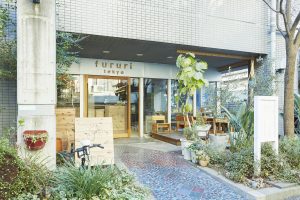
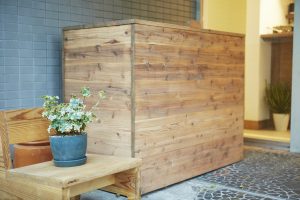
Example 2. Mont Blanc cake specialty shop, “Mont Blanc Stand”
The shop is located in Kamakura, where many tourists visit throughout the year. While tourists make the town lively, and support the economics of the town, they could also cause garbages on the streets. To avoid this garbage problem, we have come up with this small campaign. If you bring your mont blanc cup back to the shop after finishing it, you will get small meringues desserts! This is only a small action, but this is what we can do. This is a step for protecting the environment and landscape of the town with our own actions.


Goal 14: Life below water
14.1 By 2025, prevent and significantly reduce marine pollution of all kinds, in particular from land-based activities, including marine debris and nutrient pollution
14.2 By 2020, sustainably manage and protect marine and coastal ecosystems to avoid significant adverse impacts, including by strengthening their resilience, and take action for their restoration in order to achieve healthy and productive oceans
14.3 Minimize and address the impacts of ocean acidification, including through enhanced scientific cooperation at all levels
14.4 By 2020, effectively regulate harvesting and end overfishing, illegal, unreported and unregulated fishing and destructive fishing practices and implement science-based management plans, in order to restore fish stocks in the shortest time feasible, at least to levels that can produce maximum sustainable yield as determined by their biological characteristics
14.5 By 2020, conserve at least 10 per cent of coastal and marine areas, consistent with national and international law and based on the best available scientific information
14.6 By 2020, prohibit certain forms of fisheries subsidies which contribute to overcapacity and overfishing, eliminate subsidies that contribute to illegal, unreported and unregulated fishing and refrain from introducing new such subsidies, recognizing that appropriate and effective special and differential treatment for developing and least developed countries should be an integral part of the World Trade Organization fisheries subsidies negotiation
14.7 By 2030, increase the economic benefits to Small Island developing States and least developed countries from the sustainable use of marine resources, including through sustainable management of fisheries, aquaculture and tourism
14.A Increase scientific knowledge, develop research capacity and transfer marine technology, taking into account the Intergovernmental Oceanographic Commission Criteria and Guidelines on the Transfer of Marine Technology, in order to improve ocean health and to enhance the contribution of marine biodiversity to the development of developing countries, in particular small island developing States and least developed countries
14.B Provide access for small-scale artisanal fishers to marine resources and markets
14.C Enhance the conservation and sustainable use of oceans and their resources by implementing international law as reflected in UNCLOS, which provides the legal framework for the conservation and sustainable use of oceans and their resources, as recalled in paragraph 158 of The Future We Want

Over the past few years, plastics have been attracting attention in terms of its environmental influence. We, kusukusu Inc., are working on creating biodegradable products that don’t cause any negative influence on the natural environment. We are still on the planning process, but you can check out what we are working on in this article, Biodegradable Product.
Goal 15: Life on land
15.1 By 2020, ensure the conservation, restoration and sustainable use of terrestrial and inland freshwater ecosystems and their services, in particular forests, wetlands, mountains and drylands, in line with obligations under international agreements
15.2 By 2020, promote the implementation of sustainable management of all types of forests, halt deforestation, restore degraded forests and substantially increase afforestation and reforestation globally
15.3 By 2030, combat desertification, restore degraded land and soil, including land affected by desertification, drought and floods, and strive to achieve a land degradation-neutral world
15.4 By 2030, ensure the conservation of mountain ecosystems, including their biodiversity, in order to enhance their capacity to provide benefits that are essential for sustainable development
15.5 Take urgent and significant action to reduce the degradation of natural habitats, halt the loss of biodiversity and, by 2020, protect and prevent the extinction of threatened species
15.6 Promote fair and equitable sharing of the benefits arising from the utilization of genetic resources and promote appropriate access to such resources, as internationally agreed
15.7 Take urgent action to end poaching and trafficking of protected species of flora and fauna and address both demand and supply of illegal wildlife products
15.8 By 2020, introduce measures to prevent the introduction and significantly reduce the impact of invasive alien species on land and water ecosystems and control or eradicate the priority species
15.9 By 2020, integrate ecosystem and biodiversity values into national and local planning, development processes, poverty reduction strategies and accounts
15.A Mobilize and significantly increase financial resources from all sources to conserve and sustainably use biodiversity and ecosystems
15.B Mobilize significant resources from all sources and at all levels to finance sustainable forest management and provide adequate incentives to developing countries to advance such management, including for conservation and reforestation
15.C Enhance global support for efforts to combat poaching and trafficking of protected species, including by increasing the capacity of local communities to pursue sustainable livelihood opportunities
To harmonize with the nature, this is the core of our vision.
The Sustainable Development Goals
What’s SDGs?
“The Sustainable Development Goals (SDGs), otherwise known as the Global Goals, are an universal call to action to end poverty, protect the planet and ensure that all people enjoy peace and prosperity” (UNDP).
SDGs consist of 17 goals to fulfill worldwide by 2030. The goals have been set at United Nations Conference in 2015, and cover various fields such as human rights and poverty or natural environment. Every goal is made with the purpose of making the better future, leaving nobody behind.
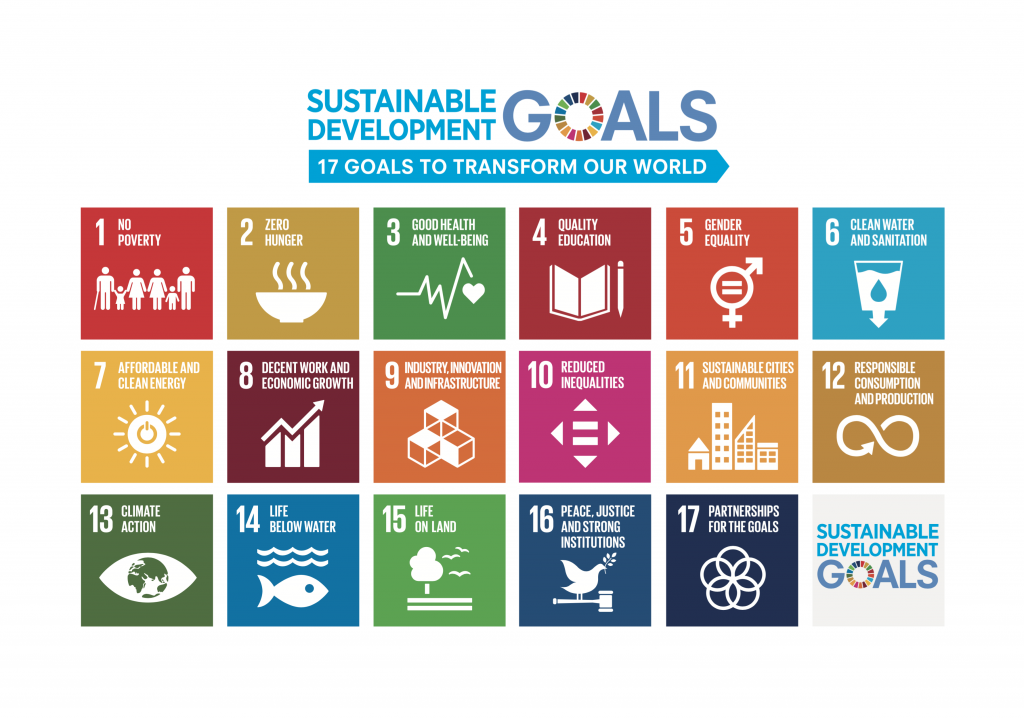
-United Nations Development Programme
Three Dimensions of Sustainable Development
“Sustainable development has been defined as development that meets the needs of the present without compromising the ability of future generations to meet their own needs” (Department of Public Information UN). To achieve the goals, it is crucial to harmonize the three elements; economic growth, social inclusion and environmental protection.

Another Way to Look at SDGs – The Five Ps
“The Goals and targets will stimulate action over the next 15 years in areas of critical importance: people, planet, prosperity, peace and partnership”(Department of Public Information UN).
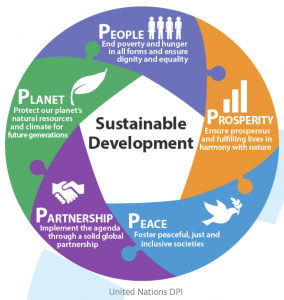
The 17 goals and 169 targets of SDGs
The Goals consist of total 169 targets. The followings are the 17 goals and some of the targets.
Goal 1: No poverty
1.3 Implement nationally appropriate social protection systems and measures for all, including floors, and by 2030 achieve substantial coverage of the poor and the vulnerable
1.4 By 2030, ensure that all men and women, in particular the poor and the vulnerable, have equal rights to economic resources, as well as access to basic services, ownership and control over land and other forms of property, inheritance, natural resources, appropriate new technology and financial services, including microfinance
1.5 By 2030, build the resilience of the poor and those in vulnerable situations and reduce their exposure and vulnerability to climate-related extreme events and other economic, social and environmental shocks and disasters
Goal 2: Zero hunger
2.4 By 2030, ensure sustainable food production systems and implement resilient agricultural practices that increase productivity and production, that help maintain ecosystems, that strengthen capacity for adaptation to climate change, extreme weather, drought, flooding and other disasters and that progressively improve land and soil quality.
2.C Adopt measures to ensure the proper functioning of food commodity markets and their derivatives and facilitate timely access to market information, including on food reserves, in order to help limit extreme food price volatility.
Goal 3: Good health and well-being
3.4 By 2030, reduce by one third premature mortality from non-communicable diseases through prevention and treatment and promote mental health and well-being.
3.9 By 2030, substantially reduce the number of deaths and illnesses from hazardous chemicals and air, water and soil pollution and contamination.
Goal 4: Quality education
4.1 By 2030, ensure that all girls and boys complete free, equitable and quality primary and secondary education leading to relevant and Goal-4 effective learning outcomes
4.5 By 2030, eliminate gender disparities in education and ensure equal access to all levels of education and vocational training for the vulnerable, including persons with disabilities, indigenous peoples and children in vulnerable situations
4.A Build and upgrade education facilities that are child, disability and gender sensitive and provide safe, nonviolent, inclusive and effective learning environments for all
Goal 5: Gender Equality
5.1 End all forms of discrimination against all women and girls everywhere
5.4 Recognize and value unpaid care and domestic work through the provision of public services, infrastructure and social protection policies and the promotion of shared responsibility within the household and the family as nationally appropriate
Goal 6: Clean water and sanitation
6.4 By 2030, substantially increase water-use efficiency across all sectors and ensure sustainable withdrawals and supply of freshwater to address water scarcity and substantially reduce the number of people suffering from water scarcity
6.B Support and strengthen the participation of local communities in improving water and sanitation management
Goal 7: Affordable and clean energy
7.1 By 2030, ensure universal access to affordable, reliable and modern energy services
7.A By 2030, enhance international cooperation to facilitate access to clean energy research and technology, including renewable energy, energy efficiency and advanced and cleaner fossil-fuel technology, and promote investment in energy infrastructure and clean energy technology
Goal 8: Decent work and economic growth
8.3 Promote development-oriented policies that support productive activities, decent job creation, entrepreneurship, creativity and innovation, and encourage the formalization and growth of micro-, small- and medium-sized enterprises, including through access to financial services
8.5 By 2030, achieve full and productive employment and decent work for all women and men, including for young people and persons with disabilities, and equal pay for work of equal value
Goal 9: Industries, Innovation, and Infrastructure
9.1 Develop quality, reliable, sustainable and resilient infrastructure, including regional and transborder infrastructure, to support economic development and human well-being, with a focus on affordable and equitable access for all
9.4 By 2030, upgrade infrastructure and retrofit industries to make them sustainable, with increased resource-use efficiency and greater adoption of clean and environmentally sound technologies and industrial processes, with all countries taking action in accordance with their respective capabilities
Goal 10: Reduced Inequality
10.2 By 2030, empower and promote the social, economic and political inclusion of all, irrespective of age, sex, disability, race, ethnicity, origin, religion or economic or other status
10.7 Facilitate orderly, safe, regular and responsible migration and mobility of people, including through the implementation of planned and well-managed migration policies
Goal 11: Sustainable cities and communities
11.2 By 2030, provide access to safe, affordable, accessible and sustainable transport systems for all, improving road safety, notably by expanding public transport, with special attention to the needs of those in vulnerable situations, women, children, persons with disabilities and older persons
11.3 By 2030, enhance inclusive and sustainable urbanization and capacity for participatory, integrated and sustainable human settlement planning and management in all countries
Goal 12: Responsible consumption and production
12.3 By 2030, halve per capita global food waste at the retail and consumer levels and reduce food losses along production and supply chains, including post-harvest losses
12.4 By 2020, achieve the environmentally sound management of chemicals and all wastes throughout their life cycle, in accordance with agreed international frameworks, and significantly reduce their release to air, water and soil in order to minimize their adverse impacts on human health and the environment
Goal 13: Climate Action
13.1 Strengthen resilience and adaptive capacity to climate-related hazards and natural disasters in all countries
13.3 Improve education, awareness-raising and human and institutional capacity on climate change mitigation, adaptation, impact reduction and early warning
Goal 14: Life below water
14.1 By 2025, prevent and significantly reduce marine pollution of all kinds, in particular from land-based activities, including marine debris and nutrient pollution
14.2 By 2020, sustainably manage and protect marine and coastal ecosystems to avoid significant adverse impacts, including by strengthening their resilience, and take action for their restoration in order to achieve healthy and productive oceans
Goal 15: Life on land
15.2 By 2020, promote the implementation of sustainable management of all types of forests, halt deforestation, restore degraded forests and substantially increase afforestation and reforestation globally
15.4 By 2030, ensure the conservation of mountain ecosystems, including their biodiversity, in order to enhance their capacity to provide benefits that are essential for sustainable development
Goal 16: Peace, Justice and Strong institutions
16.5 Substantially reduce corruption and bribery in all their forms
16.B Promote and enforce non-discriminatory laws and policies for sustainable development
Goal 17: Partnerships for the goals
17.1 Strengthen domestic resource mobilization, including through international support to developing countries, to improve domestic capacity for tax and other revenue collection
17.7 Promote the development, transfer, dissemination and diffusion of environmentally sound technologies to developing countries on favourable terms, including on concessional and preferential terms, as mutually agreed
Official Websites about SDGs

UNIC Sustainable Development Goals
SDGs are the outcome of the United Nations Sustainable Development Summit held in New York in 2015. On this website, UN provides the detailed documents and information about SDGs in pdf forms which you can download freely.

UNDP Sustainable Development Goals (Global Page)
As the lead UN development agency, UNDP is uniquely placed to help implement the Goals through their work in some 170 countries and territories. On this website, you can read about the history behind SDGs and detailed information about each goal, and what UNDP does around the world. By clicking the top right corner of the website, “Around World”, you can go to your own country’s UNDP website.
![]()
Ministry of Foreign Affairs of Japan
This website shows what Japan ministry does for fulfilling the SDGs. You can also find the information about the 10 cities selected for the model cities of SDGs in Japan.

Global Compact Network Japan The SDGs
The aim of the UN Global Compact is to mobilize a global movement of sustainable companies and stakeholders to create a better world. It was established in the year of 2000 at the UN head quarter. The number of member companies and organizations are more than 13,000 in 160 countries.

GREENPEACE is a global environmental Non Government Organization which has 55 branches all over the world. The headquarter is located in Amsterdam, Austria. They have a right to take part in UN summit and give advice on environmental issues as an NGO expert in that field.
SDGs × Other Communities
Inside Japan
Kamikatsu-cho, Tokushima
Kamikatsu-cho is known as the first town that announced “Zero Waste” community policy in Japan. They have started to work on the policy in 2003, and as of 2016, the recycling rate of the whole waste in the town is as high as 81%. They have built “Waste Station” where the waste will be divided into 13 categories and 45 types of materials. They also use composting system, using locally produced Japanese cedar chips.

Shimokawa-machi, Hokkaido
The forest industry in this town is called “Circular Economy Forestry” for its unique and sustainable forestry system. The town is also known as the first town whose forest received FSC in Hokkaido. Forest Stewardship Council mark is given to a forest that meets various kinds of criteria to be certified as sustainable. They also use every part of the woods they cut; for essential oils, architecture, biomass energy supply and so on. Wood biomass heat supply in this town has started in 2014, and today, there are 11 boilers in the town and it supplies water and heat to over 30 places in the town including city hall, schools, and Japanese spas.

Ama-cho, Shimane
Once you land on this beautiful island, Amacho, you will find welcome posters that say “We can’t give what we don’t have”. This statement means, there are no convenience store or Starbucks or movie theatre in the town, but they do have incredibly beautiful nature and warm hearted people. These posters are the reflection of the positive attitude of the residents thinking that they don’t have what big cities have but they do have what big cities don’t have. In the past, the number of jobs in town decreased drastically, and in 2005, the salary for the employees there became the lowest in whole Japan. So, the residents thought about how they can rebuild the town and make it a lively community. They have decided to focus on education and industry with the philosophy of leaving nobody behind, which is the same philosophy as SDGs.

Outside Japan
Eckernförde, Germany
In many cities of Germany, the number of cars which can go inside the city is limited. Eckernförde is one of those cities. Because there is limited amount of cars, everybody including people with a child buggy or in their wheel chairs can enjoy shopping and relaxing at cafes safely. It not only reduces the environmental pollution but also contributes to energizing the city with its quality of welfare and comfort for sightseeing. 70% of all the roads in Eckernförde limit the amount of cars, and encourage bicycle use.

Malmö, Sweden
Malmö, one of the most developed cities in the field of sustainability in Sweden, adopts a system called “RECO-ring”. The system promotes the direct interactions between consumers and farmers, which encourages local production for local consumption. How does it work? Users (consumers) just need to join “Reco-ring” Facebook page, and the page will show them the vegetables member farmers can provide at that moment. If a user wants to buy any of the vegetables, he just needs to comment on the page. The payment is processed online. This system reduces not only package waste and cost, but also CO2 emission and delivery cost.
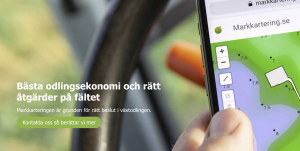
Portland, the USA
The movement of reducing food package waste is spreading all over the world. In Portland, Oregon, street food is a part of their culture, and they have a service called “Go Box” to reduce the package waste. You just need to download the app on your phone and order food at member street food shops through the app. When you arrive at the shop you ordered, they will give you your food in the Go Box. After finishing, you just put the box in one of the collection boxes in town. They collect the boxes by cycling, and washing them creates employment for homeless people in town.
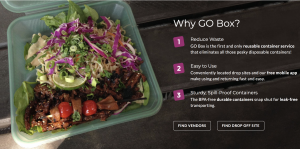
Visions of The Future
Today, people are working on creating a better world in various countries. What we can do as an individual is a small thing. However, by planting the seeds of our actions and ideas around the world, they will lead to better societies and communities. This is what we believe and live by.
Our ideas to create sustainable societies can be found on this page, Vision.
If you are interested, or have any thoughts to share, don’t hesitate to contact us through message. We’d appreciate your participation!
This website is owned and managed by a design office in Kamakura, kusukusu Inc.







